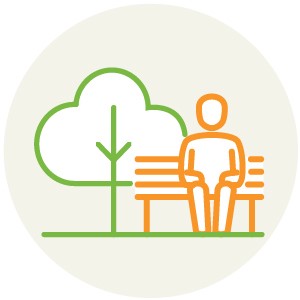Supporting facilities
On this page
Managing street furniture
Street furniture should be located in the ‘street furniture zone’ and may include:
- trees and planter boxes
- signposts, traffic signals and light poles
- parking meters
- rubbish bins
- seats and tables
- drinking fountains
- telephones, advertising signs and vending machines.
Location of street furniture and other obstacles can reduce the path width, creating ‘squeeze points’.
Elements in the streetscape, including those at the property alignment/boundary, should be designed to allow for equitable use and arranged to ensure a continuous accessible path of travel.
The colour of street furniture should contrast with the background, to assist people with vision impairments.
TMR endorsed guidance
- AS 1428.1 – 2009 Design for Access and Mobility Part 1: General Requirements for access – New building works
Useful resources
- Guide to Road Design Part 6A: Paths for Walking and Cycling, Table 2.1 Zones associated with pedestrian paths and Figure 2.1 Examples of pedestrian path zones (Austroads, 2017)
- Guide to Traffic Management Part 6: Intersections, Interchanges and Crossings Management, Table 3.13: Issues for pedestrians (Austroads, 2020)
- Public Transport Infrastructure Manual, Chapter 5 - Bus Stop Infrastructure (TransLink, 2020)
- Advisory Note on streetscape, public outdoor areas, fixtures, fittings and furniture (Australian Human Rights Commission, 2013)
- Planning and Designing for Pedestrians: Guidelines (Western Australian Government, 2016)
- Global Street Design Guide, 6.3.4 Sidewalks (Global Designing Cities Initiative, 2016)
- The Planning for Walking Toolkit 6.2.2 Local street scale mapping and analysis – Street furniture and Places to stop and rest (Transport for London, 2020)
Wayfinding signage
The purposes of wayfinding for walking are to:
- help people orientate themselves and easily find their way to their destinations
- help people to move easily between transport modes
- encourage the use of sustainable modes of transport
- give people confidence to stray from the main tourist routes and explore more of the area.
TMR endorsed guidance
- Wayfinding and Signage for People Walking (Department of Transport and Main Roads, 2020)
- AS1428.4.2 Design for access and mobility, Part 4.2: Means to assist the orientation of people with a vision impairment – Wayfinding signs
Other useful resources
- Guide to Traffic Management Part 10: Transport Control – Types of Devices, Section 5.7 Wayfinding for Pedestrians (Austroads, 2020)
- Case study: 10,000 Steps Walkway Signage Guidelines (Heart Foundation - Healthy Active by Design, 2020)
- City of Ipswich Active Transport Wayfinding Strategy and Design Manual (City of Ipswich, 2018)
- Global Street Design Guide, 6.3.9 Wayfinding (Global Designing Cities Initiative, 2016)
Lighting
Good public lighting is essential for personal security and for safe navigation.
Destinations such as public transport hubs and shopping centres are likely to have ‘after-dark’ demand from people walking so surrounding walking routes should be assessed and prioritised for lighting improvements.
TMR endorsed guidance
- Standard Drawing SD1682 Typical lighting requirements for off-road pathways (Department of Transport and Main Roads, 2018)
- Road Planning and Design Manual 2nd Edition, Volume 6 – Lighting (Department of Transport and Main Roads, 2016)
- Public Transport Infrastructure Manual, Table 3.6: Design considerations for pedestrian access infrastructure – Lighting (TransLink, 2020)
- AS/NZS 1158:2020 Lighting for Roads and Public Spaces Pedestrian area (Category P) lighting - Performance and design requirements
Other useful resources
- Guide to Road Design Part 6A: Paths for Walking and Cycling, Section 5.11 Lighting (Austroads, 2017)
- Global Street Design Guide, 7.3 Lighting and Technology (Global Designing Cities Initiative, 2016)
- Last updated 27 January 2023

